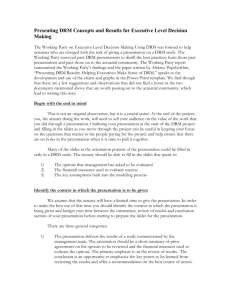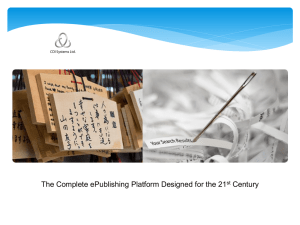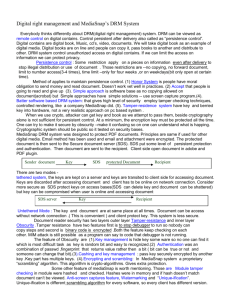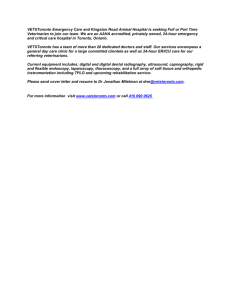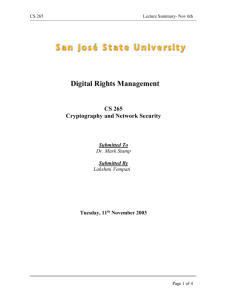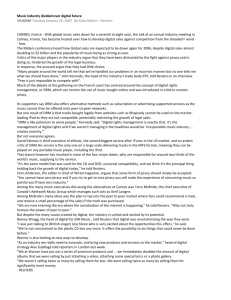New Life for AM with Digital Transmission
advertisement
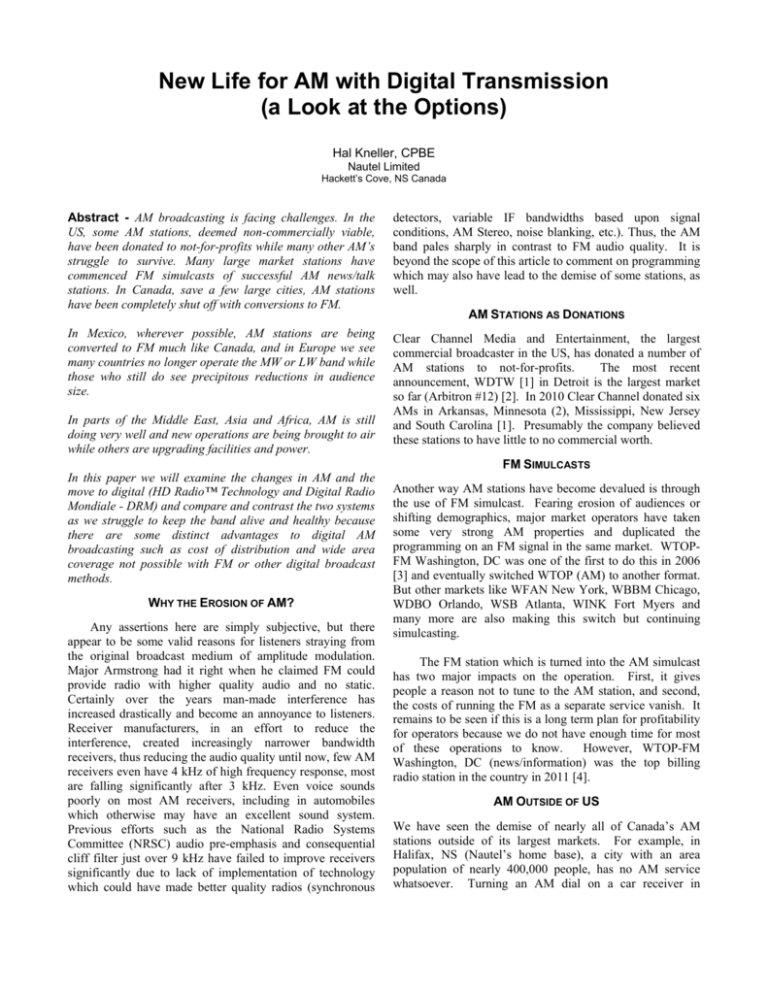
New Life for AM with Digital Transmission (a Look at the Options) Hal Kneller, CPBE Nautel Limited Hackett’s Cove, NS Canada Abstract - AM broadcasting is facing challenges. In the US, some AM stations, deemed non-commercially viable, have been donated to not-for-profits while many other AM’s struggle to survive. Many large market stations have commenced FM simulcasts of successful AM news/talk stations. In Canada, save a few large cities, AM stations have been completely shut off with conversions to FM. detectors, variable IF bandwidths based upon signal conditions, AM Stereo, noise blanking, etc.). Thus, the AM band pales sharply in contrast to FM audio quality. It is beyond the scope of this article to comment on programming which may also have lead to the demise of some stations, as well. In Mexico, wherever possible, AM stations are being converted to FM much like Canada, and in Europe we see many countries no longer operate the MW or LW band while those who still do see precipitous reductions in audience size. Clear Channel Media and Entertainment, the largest commercial broadcaster in the US, has donated a number of AM stations to not-for-profits. The most recent announcement, WDTW [1] in Detroit is the largest market so far (Arbitron #12) [2]. In 2010 Clear Channel donated six AMs in Arkansas, Minnesota (2), Mississippi, New Jersey and South Carolina [1]. Presumably the company believed these stations to have little to no commercial worth. In parts of the Middle East, Asia and Africa, AM is still doing very well and new operations are being brought to air while others are upgrading facilities and power. AM STATIONS AS DONATIONS FM SIMULCASTS In this paper we will examine the changes in AM and the move to digital (HD Radio™ Technology and Digital Radio Mondiale - DRM) and compare and contrast the two systems as we struggle to keep the band alive and healthy because there are some distinct advantages to digital AM broadcasting such as cost of distribution and wide area coverage not possible with FM or other digital broadcast methods. WHY THE EROSION OF AM? Any assertions here are simply subjective, but there appear to be some valid reasons for listeners straying from the original broadcast medium of amplitude modulation. Major Armstrong had it right when he claimed FM could provide radio with higher quality audio and no static. Certainly over the years man-made interference has increased drastically and become an annoyance to listeners. Receiver manufacturers, in an effort to reduce the interference, created increasingly narrower bandwidth receivers, thus reducing the audio quality until now, few AM receivers even have 4 kHz of high frequency response, most are falling significantly after 3 kHz. Even voice sounds poorly on most AM receivers, including in automobiles which otherwise may have an excellent sound system. Previous efforts such as the National Radio Systems Committee (NRSC) audio pre-emphasis and consequential cliff filter just over 9 kHz have failed to improve receivers significantly due to lack of implementation of technology which could have made better quality radios (synchronous Another way AM stations have become devalued is through the use of FM simulcast. Fearing erosion of audiences or shifting demographics, major market operators have taken some very strong AM properties and duplicated the programming on an FM signal in the same market. WTOPFM Washington, DC was one of the first to do this in 2006 [3] and eventually switched WTOP (AM) to another format. But other markets like WFAN New York, WBBM Chicago, WDBO Orlando, WSB Atlanta, WINK Fort Myers and many more are also making this switch but continuing simulcasting. The FM station which is turned into the AM simulcast has two major impacts on the operation. First, it gives people a reason not to tune to the AM station, and second, the costs of running the FM as a separate service vanish. It remains to be seen if this is a long term plan for profitability for operators because we do not have enough time for most of these operations to know. However, WTOP-FM Washington, DC (news/information) was the top billing radio station in the country in 2011 [4]. AM OUTSIDE OF US We have seen the demise of nearly all of Canada’s AM stations outside of its largest markets. For example, in Halifax, NS (Nautel’s home base), a city with an area population of nearly 400,000 people, has no AM service whatsoever. Turning an AM dial on a car receiver in Halifax makes it sound like the band doesn’t even exist. Throughout Canada in the last five years there has been an effort to switch off as many AM stations as possible, moving them to FM frequencies. Only in the largest cities such as Montreal, Toronto, Vancouver and a few others, where there simply was not enough FM spectrum, AMs have been turned off. Ironically, one of the most listened to stations in Canada is an AM station in Toronto – CFTR 680 Khz[5]. However, communications law in Canada does not permit an FM simulcast such as in the US or elsewhere. Mexico is on a similar plan upon which they officially embarked about four years ago and have assigned FM channels throughout much of the country to existing AM stations [6]. Certain large cities such as Mexico City will, of course, not have enough spectrum so some AMs will remain. The pattern is similar in Europe where nations such as Switzerland have no AM services, and most other countries have very few left and extremely small audiences. Even in Germany where relatively new AM transmitters were installed, services were shut down in the last two years. On the other hand, AM is doing well in some countries and regions. Asia Pacific is very strong for AM as is the Middle East as well as parts of Africa. WHAT CAN WE DO ABOUT IT? If AM and perhaps LW can be revived, it may be thanks to digitalization. There are two available digital radio platforms, HD Radio™ Technology and Digital Radio Mondiale (DRM). Recognizing that the solution is not just audio quality but also about multi-media features that both systems bring to the consumer offer a compelling argument. A LITTLE ABOUT THE SYSTEMS’ HISTORY Development for what is today known as the HD Radio system or IBOC (In Band On Channel) commenced in the US after examining an out-of-band European system in the mid 1990’s then known as Eureka 147, now commonly called DAB (Digital Audio Broadcasting) or its more modern version, DAB+. The desirable spectrum in Band III was simply not available in the US due to pending DTV reassignments. L band was rejected for both poor coverage and unavailable as the military had the frequencies needed. Thus in the mid 1990’s Project Acorn, a joint project with Gannett, CBS and Westinghouse began studying in-band solutions. Ultimately three companies (USADR, Digital Radio Express and Lucent) each with competing systems, merged and iBiquity was formed to pursue what was then to become HD Radio Technology. The first stations fully authorized (i.e. not test) by the FCC went on air in 2002. The system operates on medium wave and FM Band II. Primarily HD Radio broadcasts are in the Americas, but also operate in the Philippines, Romania and is being tested in other locations. The standards are published as NRSC-5C. The current implementation of the technology is owned by iBiquity Digital Corporation, a for profit enterprise based in the US. The standard is recognized by ITU. DRM was developed in Europe beginning in 1989 as Skywave 2000 with the first informal meeting of some short wave broadcasters and equipment manufacturers whose goal was to improve quality of AM broadcast in bands below 30 MHz. Initially the plan was to digitize the short wave bands but later, DRM standards were created to operate in medium and long wave as well. By 2004 short wave broadcasts were on the air in DRM. More recently, the DRM+ standard received approval from ITU to extend operation on VHF frequencies Bands I, II and III. DRM operates globally on short wave, and has been named the standard on medium wave in both India and Russia. The DRM Consortium has about 100 members consisting of broadcasters, equipment manufacturers and semiconductor producers and operates as a not-for-profit organization based in Switzerland. MORE ABOUT THE SYSTEMS Both DRM and HD Radio technologies are orthogonal frequency-division multiplexing (OFDM) systems employing many small digital carriers in the frequency spectrum assigned. In order to fit within the spectral bandwidth assignment, bit-reduced audio codecs are applied. But being digital, both systems use bits for data as well as for audio, and herein is the strong argument for the future with multimedia capability. While designed to eventually be all digital, both systems can operate in an interim “simulcast” or “hybrid” mode. The HD Radio system was designed initially to be operational in both analog and digital whereas with DRM, this concept came later. iBiquity calls it hybrid, and DRM calls it simulcast. Both systems have some distinct advantages and disadvantages in this mode with bandwidth requirements and digital noise to the analog host AM signal being the two major concerns. Maintaining the digital carriers at a level well below the analog is one method of interference control, and to adjacent channel stations, either asymmetrical power on IBOC or using upper or lower alternate adjacent channel for DRM can mitigate interference. Antenna specifications for DRM are significantly tighter than for IBOC due to the much tighter emission mask of DRM. However, IBOC requires more symmetry in the passband. The DRM “Introduction and Implementation Guide” recommends “...the VSWR at ± 10 kHz from centre should be not greater than 1.1:1 and not greater than 1.05:1 at ± 5 kHz from centre. Performance parameters better than this may be required for the satisfactory radiation of DRM 18/20 kHz wideband signals” [6]. iBiquity recommends VSWR to be no worse than 1.2:1 out to 10 kHz from carrier and no worse than 1.4:1 out to 15 kHz. Plus symmetry is required. Example: X Ohms at +j6 @ 5 kHz below carrier must equal X Ohms at –j6 @ 5 kHz above carrier. Output network of transmitter must be factored into the phase rotation calculations [8]. Transmitter amplifier requirements are quite similar for both systems. However, according to one manufacturer, a transmitter making the mask for DRM may be tricky if the mask is marginal on HD Radio performance [9]. Simulcast Principles DRM Simulcast using a 18kHz Bandwidth Fc Fc DRM DRM AM 9 As can clearly be seen, either DRM or HD Radio systems require additional bandwidth over the standard AM allocation when utilizing the hybrid or simulcast modes. However, in the case of the US, HD Radio broadcasting fits underneath a modified Federal Communications (FCC) “mask” so that it appears to not exceed allowed bandwidth. Both systems offer an eventual all-digital solution which is the obvious final goal. Once the band is cleared of analog signals and is fully digital (with either system), interference is reduced, coverage is improved and a better listener experience results. In the all digital world, DRM could occupy a single channel, but iBiquity shows the all digital system at ±15 kHz from center carrier. AM 4.5 4.5 4.5 4.5 9 9 9 DRM in lower frequencies AM in upper frequencies DRM in upper frequencies AM in lower frequencies Lower Digital Sidebands Secondary AM 5 AM 5 5 5 DRM Not Used Fc Not Used Not Used Fc Not Used Primary 0,5 0,5 9 Primary Tertiary DRM Simulcast using a 20kHz Bandwidth DRM Upper Digital Sidebands 9 10 10 DRM in lower frequencies DRM in upper frequencies Above shows carrier placements for both analog and DRM in various possible simulcast modes for both double channel 9 and 10 KHz spacing (Nautel Limited). Frequency (Hz) -9448 -4906 Subcarrier Index -52 -27 -182 -1 0 182 0 1 4906 9448 27 52 HD Radio MA3 All Digital mode (iBiquity Digital) WHAT BITRATES ARE AVAILABLE? 30 kHz HD Radio technology Full Hybrid AM System (5 kHz analog bandwidth) (iBiquity Digital) 30 kHz HD Radio technology Reduced Bandwidth Hybrid AM System (10 kHz analog audio bandwidth) (iBiquity Digital) One additional feature about DRM is that the broadcaster can select coverage over bitrate or vice versa as well as various bandwidths depending upon the situation. The bitrates in HD Radio are somewhat less variable (refer to the charts below) with currently two modes of hybrid and two modes of full digital operation. In the case of DRM, the “robustness” and the bitrate are a tradeoff. For medium wave one would use no greater than mode D (mode E is for DRM+ in the VHF band). In the case of HD Radio Technology, the MA1 reduced hybrid bandwidth configuration was introduced to both reduce analog host interference as well as to improve the listener experience by eliminating the receiver’s ability to operate in the enhanced mode (greater fidelity and full stereo) which would drop in and out under certain reception conditions. Thus the system would remain in what is called the core mode. Another advantage is that by using this mode, the analog frequency response can be out to the full 9.4 kHz allowed by the FCC. In all cases with HD Radio modes PIDS (Primary Information Data Services) is 0.4 kb/s. The bitrates are sufficient in both systems to provide nearly FM stereo quality audio. Noise and static are eliminated. The analog host interference issues are much more receiver than transmitter related due to the inability of receivers to eliminate the digital “hash” so close to the analog carrier frequency. Transmitter spectrum analyzer pictures show no transmission interference (assuming antenna system is in compliance with standards). Modes and Bitrates for DRM (DRM Implementation Guide) MODE (Total Kb/s) MA1 Full Hybrid Mode (36.8) MA1 Hybrid Reduced Digital b/w Config (20.6) MA3 Full All-Digital (40.8) MA3 All-Digital Reduced Digital b/w Config (20.6) Kb/s P1 20.2 20.2 Kb/s P3 16.2 N/A Kb/s PIDS .4 .4 20.2 20.2 20.2 N/A .4 .4 Modes and Bitrates for HD Radio Technology (Data provided by iBiquity Digital) WHY HYBRID OR SIMULCAST? While the ultimate goal is to create an all-digital band which would have numerous advantages, we cannot overlook the difficulty of a rapid analog switch off such as has been done with digital television conversion. First, there is really no spectrum to give back and millions of listeners would be instantly disenfranchised. So the hybrid or simulcast modes provide the opportunity to create an orderly market transfer to the technology, offering the audio quality and other multimedia benefits to the consumer as they purchase new receivers. Neither system is a panacea in the hybrid or simulcast modes, with most problems manifesting themselves as host analog interference. Typically it is heard as a “frying bacon” or white noise sound in analog radios. Improper transmission antenna matching exacerbates this as well. To mitigate the problem, iBiquity has developed the MA1 hybrid reduced bandwidth mode and DRM requires a strict power limit on the digital signal which is -14 to -16 dBc with reference to the analog [10]. Applying in-band digital signals to what was previously analog-only broadcasting is certainly an ingenious solution, but with any such use of digital signals there is certain to create some level of interference to analog operations. Thus, techniques to minimize the interference have been noted within the industry. Examples include limiting the digital power level overall or reducing the carrier levels on one side, in the case of HD Radio broadcasting. Crawford Broadcasting had extensive experience with this, operating IBOC on 740 kHz in the Los Angeles area with 20 kHz spacing to 760 kHz in San Diego with significant amounts of salt water over the signal path. A great deal of the interference was eliminated to the 760 frequency by the asymmetrical reduction of the upper digital sidebands of 740 [11]. In the case of DRM, the digital can be on the channel above or below the analog, whichever would produce the least interference to a neighbor. AUDIO CODECS Both systems have bit rate limitations, of course, so bit reduced audio codecs are required. iBiquity had its codec developed by Coding Technologies (now Dolby) and calls it HDC. It is proprietary and firm details on it are not published. Some have called it similar to AAC+ with SBR. It has a dual mode capability when using the two AM modes (core and enhanced). DRM utilizes the AAC standard, so we believe the codecs are quite similar in efficiency and audio quality at a given bit rate although iBiquity claims they might have a slight edge at lower bit rates. RADIO WITH PICTURES (AND MORE) Earlier it was stated that today listeners expect more than just audio with their consumption of media. Certainly the poor audio quality, static and noise of AM frustrated listeners over the years. With the digital technologies we can clean up the audio and add many more multimedia aspects. Radio with pictures is really more than just that, it could include a myriad of additional rich features such as using smart phones as a back channel for interactivity. The two systems have developed many additional features which while in some cases are common in concept are called different things. supports in its architecture, is available as a potential future upgrade with IBOC. TAG it button to capture purchase token iBiquity’s Artist Experience on automotive radio (courtesy iBiquity) What DRM calls Slide Show is analogous to the HD Radio Artist Experience. This is the ability to post album art, advertiser logo/picture or station logo on a compatible receiver’s display. Many features from the Eureka 147 DAB (and now DAB+) system have been harmonized in DRM such as Journaline, a text based service for news, sports and information. iBiquity developed a system known as iTunes Tagging which permits a listener with a compatible receiver to “tag” a song he may wish to purchase. The receiver remembers this tag, and when the device is placed on line, interfaces with the iTunes store and brings up the selected tagged items. This could then allow instant purchase of the songs. Meanwhile, DRM developed a small scale motion video playout system called Diveemo which can even be used with the lower bit rate medium wave broadcasts. iTunes Tagging Radio (courtesy iBiquity Digital) Both systems are capable of showing station information (call letters, station name) and artist, title and program name in simple text on receiver displays. Also both systems embrace the international traffic standards of TPEG. While we see many differences both offer a richer media experience to the listener. Both systems also offer emergency alert systems when required. Receivers are available in various platforms and feature support is receiver dependent. COST ADVANTAGES Both systems show great promise in all digital mode to reducing transmission costs dramatically. Tests by the British Broadcasting Corporation [12] and others in terms of the digital power requirements to equal a given analog coverage have shown 5-10% of analog power in the digital mode can equal analog coverage using a DRM digital signal. iBiquity and the NRSC have recently performed some alldigital tests which is the subject of another paper this year at the NAB Engineering conference, but similar results would be expected. Another aspect is coverage area. While FM and other digital systems rely on VHF (or UHF) frequencies and are restricted by line-of-sight or terrain limitations, medium wave can extend long past the horizon or terrain to provide digital coverage. In rural or low population areas where coverage is required, this is a highly cost-effective method of distribution compared to a network of VHF or UHF repeater systems. Small scale motion video (Diveemo) over medium wave broadcast (courtesy DRM Consortium) iBiquity says not all of the features currently available on the FM system are deployed on AM but the architecture certainly supports it. For example, Artist Experience requires a mere 4 kb/s. Even the potential to multicast AM (more than one program stream simultaneously) which DRM SUMMARY It is evident from the number of AM IBOC and DRM transmissions which have been placed into operation, or trials conducted, that the technologies do work. There are ongoing efforts to improve both transmission and receivers and to add more consumer features some of which have the potential to be revenue producers for broadcasters. Certainly the lack of receivers in the beginning hindered both systems and at the moment, HD Radio does offer many more receiver models and platforms. With the build out of DRM in India, a great opportunity exists for those receivers to become plentiful and cost effective as well. The technologies have some similarities – exciters are similar as are the RF amplifier requirements, and both require at least a verification of antenna performance at minimum, and some work if compliance is not within specifications. With bandwidth limitations in cellular networks, with data being metered and charged by the kilobyte, and with the extensive coverage offered by broadcast, particularly medium wave and long wave, digital radio has a major set of advantages working for itself. [8] iBiquity Digital Corp via Power Point presentations. [9] Hardy, Tim, (Head of Engineering) Nautel Limited, [10] DRM Introduction and Implementation Guide (2012) DRM Consortium p. 25. [11] Alexander, Cris (Crawford Broadcasting) “Local Oscillator” Engineering Newsletter January 2010 [12] Murphy, Andrew Research White Paper WHP174, British Broadcasting Corporation “The Plymouth Digital Radio Mondiale (DRM) Trial Long Term Reception Results”. February 2009. HD Radio is a registered trademark of iBiquity Digital Corp. ACKNOWLEDGMENTS REFERENCES Detweiler, Jeff iBiquity Digital Corporation [1] Radio World http://www.radioworld.com/article/clearchannel-donates-detroit-station/216779 Hardy, Tim Nautel Limited [2] Arbitron http://www.arbitron.com/home/mm001050.asp Kelly, Charles W. Nautel Limited [3] Wikipedia http://en.wikipedia.org/wiki/WTOP-FM Stimson, Leslie Radio World Newspaper [4] Radio Ink http://en.wikipedia.org/wiki/WTOP-FM Project Office Digital Radio Mondiale Consortium [5] BBM Ratings August-November 2012 [6] Radio World http://www.radioworld.com/article/mexicanam%E2%80%93fm-transition-sought/1140 [7] DRM Introduction and Implementation Guide (2012) DRM Consortium p. 61.
